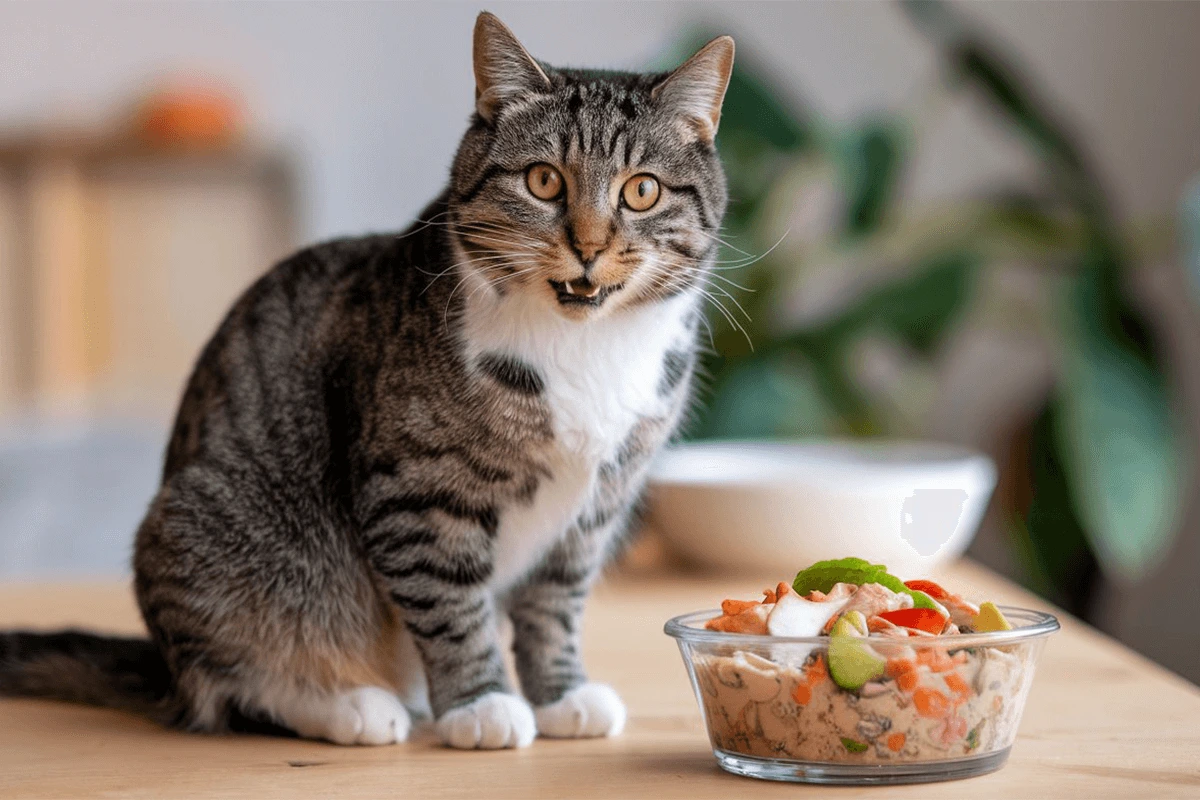Feeding your cat a fresh cat food diet is one of the best ways to support their overall health, energy levels, and longevity. Unlike processed kibble or canned food, fresh meals provide essential nutrients in their most natural form, helping your cat thrive with better digestion, a shinier coat, and increased vitality. Whether you choose homemade recipes or high-quality store-bought options, fresh food can make a significant difference in your cat’s well-being.
Many cat owners hesitate to switch to fresh food because they worry about preparation time, nutritional balance, or cost. However, with the right approach, feeding your cat a healthy fresh cat food diet can be easy, affordable, and incredibly beneficial. This guide will walk you through the top 10 expert-backed tips for choosing, preparing, and serving fresh meals to keep your feline friend happy and healthy.
Why Fresh Cat Food is Essential for Your Feline’s Health
Nutrient-Rich Cat Food
Your cat needs a diet rich in essential nutrients to stay healthy and active. Unlike humans, cats are obligate carnivores, which means they rely primarily on animal-based proteins for survival. A nutrient-rich cat food diet should include high-quality protein sources like chicken, turkey, beef, or fish, which provide the amino acids necessary for muscle maintenance and energy production.
Taurine, an essential amino acid, plays a crucial role in your cat’s heart health, vision, and immune function. Without enough taurine, cats can suffer from severe health issues like blindness or heart disease. Omega-3 and Omega-6 fatty acids also support a cat’s skin and coat health, reducing inflammation and promoting a shiny, soft coat. Vitamins and minerals such as calcium, phosphorus, and vitamin D help maintain strong bones and overall body function.
Feeding your cat fresh, whole foods ensures they get these vital nutrients in their most natural and digestible form. Unlike highly processed foods that lose nutrients during manufacturing, fresh food retains its original nutritional value, offering optimal benefits for your furry friend.
Fresh Cat Food Benefits
Switching your cat to a fresh cat food diet can significantly improve their overall health. Fresh meals are easier to digest than dry kibble, which often contains fillers like corn, wheat, and artificial preservatives. Cats that eat fresh food tend to have better digestion, which means fewer hairballs, less bloating, and healthier stools.
A diet made from fresh, whole ingredients also strengthens a cat’s immune system. High-quality proteins and natural vitamins support a strong defense against illnesses and infections. Many cat owners notice increased energy levels in their pets after switching to fresh food. This happens because fresh meals provide optimal fuel for muscle growth, organ function, and daily activity.
Another major benefit is improved hydration. Many cats struggle to drink enough water, which can lead to kidney disease or urinary tract issues. Fresh food contains higher moisture levels than dry kibble, helping cats stay hydrated naturally. Whether you choose raw or gently cooked meals, fresh food supports better hydration, digestion, and long-term health.
Balanced Diet for Cats
Providing a well-balanced diet is essential for your cat’s long-term health. A balanced diet for cats must include the right proportions of protein, fat, and essential nutrients to support their unique dietary needs. Protein should make up the majority of their diet, as it fuels their muscles and overall body function. Animal-based proteins like chicken, beef, lamb, and fish provide the necessary amino acids that cats cannot produce on their own.
Healthy fats, such as those from fish oil or animal fat, contribute to brain function, energy levels, and coat health. Omega-3 and Omega-6 fatty acids help reduce inflammation and promote a sleek, shiny coat. Cats also need small amounts of fiber from sources like pumpkin or certain vegetables to support digestion and gut health.
Unlike dogs or humans, cats do not require carbohydrates in their diet. However, if you choose to include plant-based ingredients, make sure they are easily digestible and used in moderation. The best way to ensure a balanced diet is to follow guidelines set by AAFCO (Association of American Feed Control Officials) or consult a veterinarian for a well-formulated meal plan. By maintaining the right balance of nutrients, you can help your cat live a longer, healthier, and happier life.
Choosing the Best Fresh Cat Food for Your Kitty
Fresh vs. Processed Cat Food
Choosing between fresh cat food and processed options can feel overwhelming, but understanding the key differences makes it easier. Fresh cat food consists of whole, minimally processed ingredients that retain their natural nutrients, while processed cat food, such as kibble and canned meals, often undergoes high-heat cooking that reduces nutritional value.
Processed cat food typically contains artificial preservatives, fillers like corn or wheat, and lower-quality meat by-products that provide less digestible protein. These ingredients can contribute to weight gain, digestive issues, and long-term health problems like diabetes or kidney disease. On the other hand, fresh food—whether raw or gently cooked—delivers essential nutrients in a form that cats can easily digest and absorb.
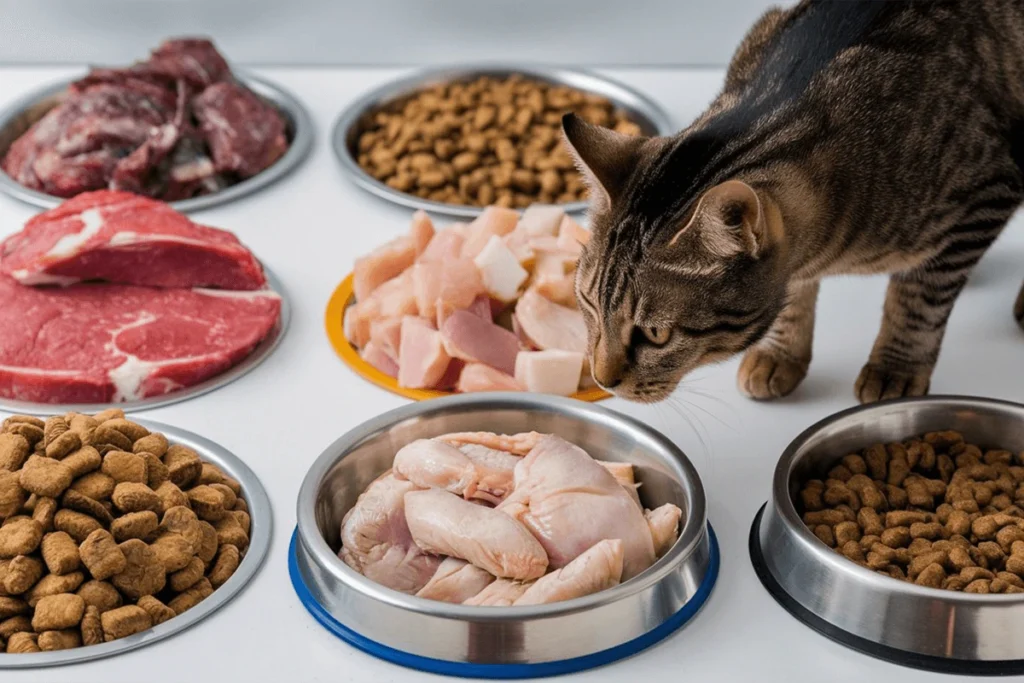
Cats on a fresh diet often experience improved energy levels, healthier skin and coat, and better hydration since fresh food contains more moisture than dry kibble. While processed food may be more convenient and have a longer shelf life, fresh food offers superior health benefits. If switching completely to fresh meals isn’t an option, gradually incorporating fresh food into your cat’s diet can still provide significant advantages.
Vet-Recommended Cat Food
Veterinarians emphasize the importance of feeding cats a high-protein, nutrient-rich diet tailored to their natural needs. Many vets recommend fresh food over highly processed options because it supports overall health, digestion, and hydration. A vet-approved fresh cat food diet typically includes high-quality animal proteins, balanced fats, and essential vitamins and minerals.
One of the biggest concerns vets have about cat nutrition is taurine deficiency. Taurine is crucial for heart health, vision, and immune function, and it is only found in animal-based proteins. Fresh meat sources, such as chicken, turkey, and fish, provide natural taurine, ensuring your cat gets what they need without synthetic additives.
Some veterinarians also recommend fresh food for cats with specific health conditions, such as kidney disease, obesity, or food allergies. Fresh meals are easier to digest and contain fewer inflammatory ingredients, making them a great option for sensitive cats. However, it’s essential to follow vet guidelines when preparing homemade meals to ensure proper nutrient balance. If you’re unsure which fresh food option is best for your cat, consult your veterinarian for personalized recommendations.
Top Fresh Cat Food Brands
If you want the benefits of fresh food without the hassle of making it yourself, several high-quality brands offer nutritionally complete fresh meals for cats. The best fresh cat food brands use human-grade ingredients, high-quality proteins, and balanced nutrient profiles to support feline health.
Some popular fresh cat food brands include:
- Smalls – This brand provides fresh, human-grade meals made with real meat and no artificial additives. They offer different textures (smooth or chunky) to suit picky eaters.
- Nom Nom – Known for vet-formulated, high-protein fresh meals, Nom Nom ensures each recipe meets AAFCO standards for balanced feline nutrition.
- JustCats by JustFoodForDogs – This brand specializes in lightly cooked fresh food with simple, high-quality ingredients and no fillers.
- Darwin’s Natural Pet Products – Offers raw, minimally processed cat food with carefully selected meats to maximize nutrient retention.
- Open Farm – Provides fresh and freeze-dried raw food options using ethically sourced, high-quality ingredients.
When choosing a brand, look for options that use real, whole-food ingredients without unnecessary fillers or artificial preservatives. A fresh food subscription service can also be a convenient way to ensure your cat gets high-quality meals delivered straight to your door.
Fresh Homemade vs. Store-Bought Cat Food – What’s Best?
Homemade vs. Store-Bought Cat Food
Deciding between homemade cat food and store-bought fresh meals depends on your time, budget, and comfort level with meal preparation. Both options can provide high-quality nutrition, but they come with different benefits and challenges.
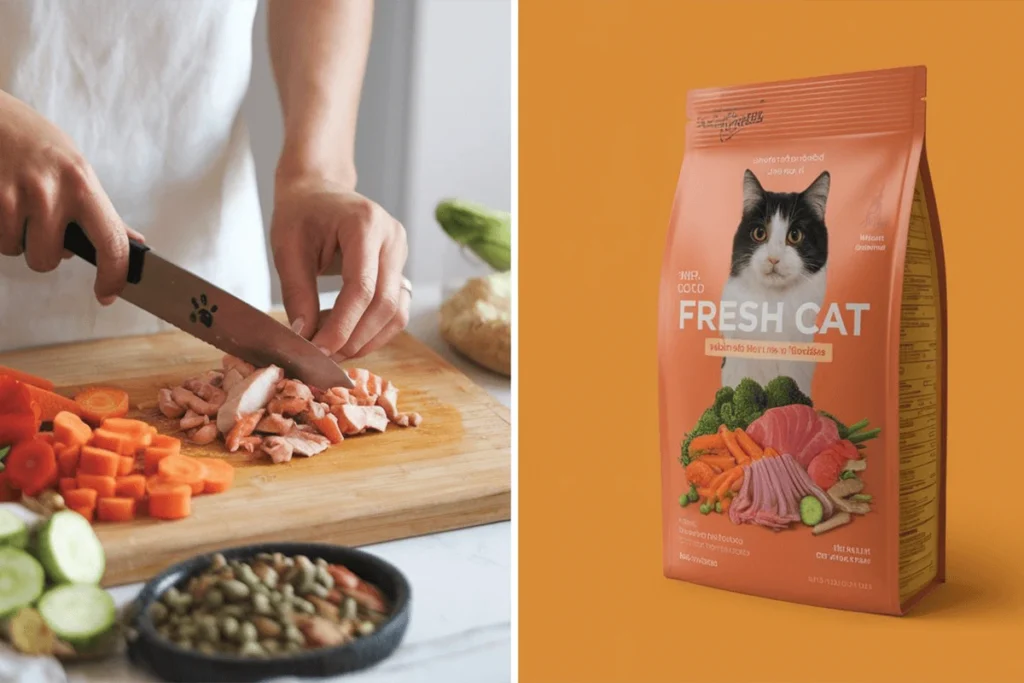
Homemade cat food allows you to control every ingredient, ensuring your cat gets fresh, whole foods without unnecessary additives or preservatives. You can tailor the diet to meet your cat’s specific needs, whether they require a high-protein, low-carb diet or have food sensitivities. However, preparing balanced homemade meals requires research and planning. Cats need precise levels of essential nutrients like taurine, Omega-3 fatty acids, and vitamins, and failing to provide them can lead to severe health issues.
Store-bought fresh cat food, on the other hand, is formulated by experts to meet a cat’s nutritional needs. Many reputable brands follow veterinary guidelines and use high-quality ingredients, ensuring balanced meals without the hassle of preparing food yourself. While store-bought fresh food is more convenient, it can be more expensive than making your own. The best approach depends on your lifestyle—some pet owners mix both homemade and store-bought options to get the best of both worlds.
Human-Grade Ingredients
Not all pet food ingredients are created equal, and human-grade ingredients offer a higher level of quality and safety. The term “human-grade” means the food meets the same standards as those used for human consumption, ensuring that every ingredient is safe, fresh, and free from harmful additives.
Many commercial pet foods use feed-grade ingredients, which may contain lower-quality meats, fillers, and preservatives that humans wouldn’t eat. These can include meat by-products, artificial flavors, and cheap grains that provide little nutritional value. In contrast, human-grade fresh cat food contains real meat, fresh vegetables, and natural supplements to provide optimal nutrition.
Feeding your cat food made with human-grade ingredients reduces the risk of contamination, improves digestibility, and supports better overall health. If you’re preparing homemade meals, always use high-quality proteins like chicken, turkey, beef, or fish, and avoid ingredients that could be harmful to cats, such as onions, garlic, and excessive carbohydrates.
AAFCO Standards
Ensuring your cat’s diet is nutritionally complete requires following proper guidelines, and the AAFCO (Association of American Feed Control Officials) sets the standard for pet food nutrition. AAFCO establishes the minimum nutrient requirements for cats based on their life stage (kitten, adult, senior), helping pet owners and manufacturers provide balanced meals.
AAFCO-approved foods must meet specific protein, fat, vitamin, and mineral levels to support feline health. If you’re feeding commercial fresh cat food, look for brands that state they meet or exceed AAFCO standards. This ensures the food provides all essential nutrients without requiring additional supplements.
For those preparing homemade meals, achieving AAFCO balance can be more challenging. Cats require precise amounts of taurine, calcium, phosphorus, and essential fatty acids, which may be difficult to measure without professional guidance. To ensure proper nutrition, consult a veterinarian or use a vet-formulated recipe that meets AAFCO guidelines. Some pet owners also add commercial supplements designed to balance homemade cat food to ensure their feline gets all necessary nutrients.
By choosing AAFCO-compliant fresh food—whether homemade or store-bought—you can confidently provide a well-rounded diet that supports your cat’s long-term health and well-being.
Transitioning Your Cat to a Fresh Food Diet
Gradual Diet Changes
Switching your cat to a fresh cat food diet requires a slow and careful transition to prevent digestive upset. Cats have sensitive stomachs, and a sudden change in diet can lead to vomiting, diarrhea, or refusal to eat. To make the transition smooth, introduce fresh food gradually over 7 to 10 days.
Begin by adding a small amount of fresh food to the food your cat usually eats. Begin with a 75% old food and 25% fresh food ratio for the first few days. Gradually increase the amount of fresh food while decreasing the processed food each day. By the end of the transition period, your cat should be fully adjusted to their new diet.
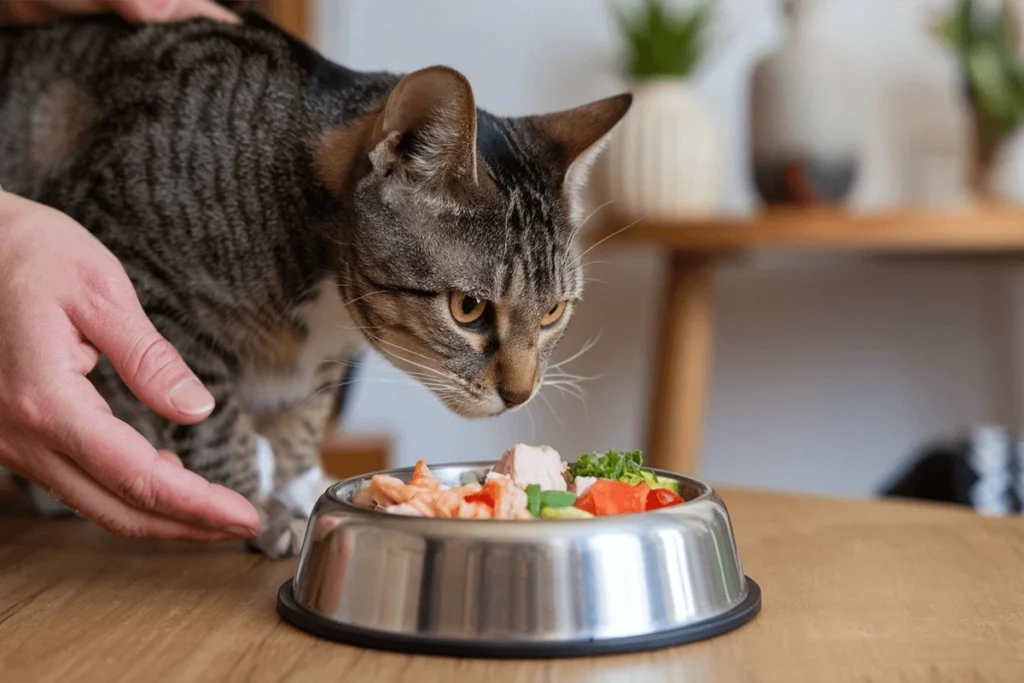
Pay attention to their eating habits and stool consistency. If your cat experiences mild digestive issues, slow down the transition process and give their stomach more time to adapt. Some cats may take longer, especially if they have been eating kibble for years. Patience is key—forcing a sudden diet switch can make your cat reject the new food altogether.
Digestive Health in Cats
A fresh diet can greatly improve digestive health in cats, but it’s important to understand how their digestive system works. Cats have short digestive tracts designed for processing high-protein, meat-based diets. They struggle to digest plant-based ingredients and artificial additives commonly found in processed foods.
Fresh cat food, whether raw or gently cooked, is easier for cats to digest because it mimics what they would eat in the wild. It contains natural enzymes and moisture that support gut health. Many cat owners notice a significant reduction in bloating, constipation, and hairballs after switching to fresh food.
Probiotics and fiber also play a role in maintaining a healthy digestive system. While cats don’t require a lot of fiber, small amounts from natural sources like pumpkin or bone broth can aid digestion. If your cat experiences persistent stomach issues, consult your vet to rule out food sensitivities or allergies.
Hydration & Nutrition Balance
Proper hydration is essential for a cat’s overall well-being, and hydration & nutrition balance go hand in hand. Unlike dogs, cats have a low thirst drive because their ancestors evolved to get most of their moisture from prey. This means that cats who eat primarily dry kibble are at higher risk of dehydration, which can lead to kidney disease, urinary tract infections, and bladder stones.
Fresh cat food naturally contains high moisture content, helping your cat stay hydrated without relying solely on water intake. Raw and cooked fresh meals typically have 65-80% moisture, compared to dry kibble, which contains only about 10%. This added hydration supports kidney function, aids digestion, and prevents urinary tract issues.
To further encourage hydration, always provide fresh water in multiple locations around your home. Some cats prefer running water, so a pet fountain can encourage them to drink more. You can also add a little bone broth to their food for extra moisture and flavor. Ensuring your cat stays properly hydrated will enhance digestion, nutrient absorption, and overall health.
Smart Tips for Storing & Serving Fresh Cat Food
Freeze-Dried Fresh Food
Many cat owners want the benefits of fresh cat food but also need the convenience of shelf-stable options. Freeze-dried fresh food offers the best of both worlds by preserving the nutritional value of fresh ingredients while making storage and serving easier.
Freeze-drying removes moisture from fresh, raw food without using high heat, which helps retain essential nutrients like taurine, Omega-3 fatty acids, and natural enzymes. Unlike traditional kibble, freeze-dried meals contain no artificial preservatives or fillers, making them a healthier alternative for cats.
To serve freeze-dried fresh food, you simply rehydrate it with water or broth before feeding. Some brands offer complete, balanced meals, while others provide freeze-dried raw meat as a topper to mix with other fresh foods. Since freeze-dried food is lightweight and has a long shelf life, it’s a great option for cat owners who travel or want to keep backup meals on hand.
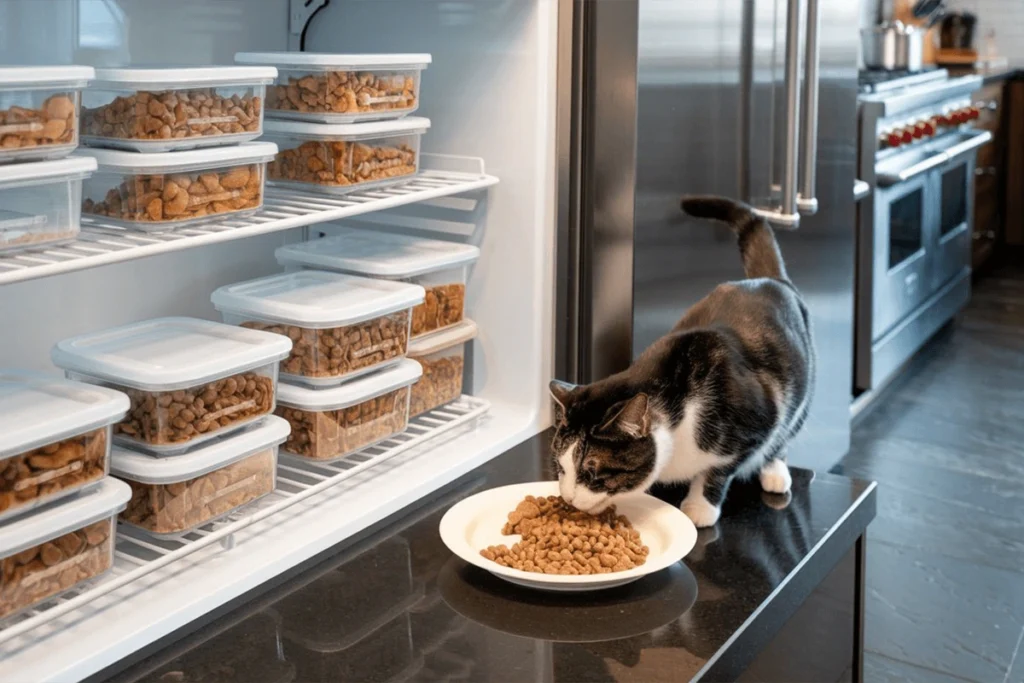
Raw and Cooked Fresh Cat Food
When feeding fresh cat food, you can choose between raw and cooked options, each with its own benefits.
- Raw fresh cat food closely mimics a cat’s natural diet in the wild. It contains raw muscle meat, organs, and bones, providing natural enzymes and unprocessed nutrients. Many believe raw feeding enhances digestion, improves coat health, and boosts energy levels. However, raw food requires careful handling to prevent bacterial contamination.
- Cooked fresh cat food offers similar nutritional benefits but with an added layer of safety. Lightly cooking the meat removes harmful bacteria while preserving most nutrients. Cooked fresh food is a great choice for cat owners who prefer not to feed raw but still want high-quality, whole-food meals.
Both raw and cooked fresh diets should be balanced with essential nutrients like taurine, calcium, and Omega-3s. If preparing meals at home, follow veterinarian-approved recipes or use high-quality commercial fresh food that meets AAFCO standards.
Fresh Cat Food Subscription Services
For busy cat owners who want high-quality meals without the hassle of preparation, fresh cat food subscription services provide a convenient solution. These services deliver fresh, pre-portioned meals tailored to your cat’s needs, ensuring proper nutrition without the guesswork.
Subscription-based fresh food brands, such as Smalls, Nom Nom, and JustCats, use human-grade ingredients and vet-approved formulas. Some services customize meal plans based on your cat’s weight, age, and dietary preferences. The food arrives frozen or refrigerated, ready to serve with minimal effort.
The biggest advantage of fresh food subscriptions is consistency. Cats thrive on routine, and receiving fresh, balanced meals regularly ensures they get proper nutrition without relying on processed kibble. While subscription services can be more expensive than traditional cat food, many pet owners find the convenience and health benefits well worth the cost.
If you’re considering a fresh food subscription, look for brands that meet AAFCO standards, offer transparent ingredient sourcing, and allow flexibility in portion sizes and delivery frequency.
Conclusion
Providing your cat with a high-quality diet is one of the best ways to support their health, happiness, and longevity. Unlike heavily processed kibble and canned food, a balanced diet with whole, natural ingredients delivers essential nutrients, moisture, and digestible proteins that promote overall well-being. Whether you choose raw or gently cooked meals, feeding fresh, nutrient-rich food ensures your feline gets the best possible nutrition without unnecessary fillers or artificial additives.
The benefits go beyond better digestion. A well-balanced diet helps maintain a strong immune system, improves skin and coat health, supports muscle growth, and reduces the risk of obesity and chronic illnesses like diabetes or kidney disease. Cats that eat fresh, carefully formulated meals tend to have more energy, fewer digestive issues, and a healthier weight compared to those on processed diets.
If you’re transitioning to fresh food, make gradual changes to prevent stomach upset and monitor your cat’s response. Some pet owners prefer homemade meals, while others rely on high-quality commercial brands or convenient fresh food subscription services. No matter which option you choose, ensure the meals meet AAFCO standards and contain essential nutrients like taurine, Omega-3 fatty acids, and high-quality animal proteins.
Investing in fresh cat food means investing in your cat’s long-term health. By prioritizing real, nutrient-dense meals, you can help your furry friend thrive, stay active, and enjoy a higher quality of life. Your cat depends on you for proper nutrition—make every meal count with wholesome, natural ingredients!
Discover the Top Homemade Cat Food & the best Recipes For a Healthy & Happy Feline!
What’s the best Cat Food Every Owner Should Know About?
Learn the Top Dry Cat Food For a Healthy & Happy Feline.
Get The Best Stuff for your Cat From Pet MD Official
